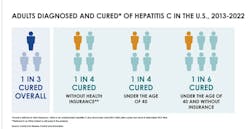A new CDC report suggests the majority of people with hepatitis C still have not been cured nearly a decade after treatments that clear the viral infection were first approved in the United States. The findings highlight the urgent need for a proposed national program that would end much of the suffering and death from hepatitis C by eliminating the disease in the United States.
It’s estimated more than 2 million people in the United States have hepatitis C, which if left untreated, often leads to serious and sometimes deadly outcomes such as liver cancer and liver failure. Despite the existence of a safe and highly effective oral cure for hepatitis C, the infection contributed to the deaths of more than 14,800 people in 2020.
The new CDC study indicates low numbers of people with known hepatitis C virus infection are being cured and provides a picture of the small proportion of people without health insurance who have been cured. The data indicate the proportions of people cured were:
- Low overall and across all age and insurance groups analyzed
- Lowest among people without health insurance or with Medicaid coverage, as well as adults under the age of 40 – a group that has the highest rates of new hepatitis C infections
- Highest among people 60 and older with Medicare or commercial insurance, yet still less than half had been cured
Current barriers to hepatitis C treatment include (but are not limited to):
- Cost of treatment
- Restrictive treatment coverage policies
- Challenges diagnosing hepatitis C

